Mitsubishi Electric PUHY-EP200YLM-A, PUHY-EP250YLM-A, PUHY-EP300YLM-A, PUHY-EP350YLM-A, PUHY-EP400YLM-A INSTALLATION MANUAL
...
<ORIGINAL>
Air-Conditioners For Building Application Inverter Y-Series
OUTDOOR UNIT |
|
PUHY-EP-YLM-A (-BS) |
For use with R410A |
INSTALLATION MANUAL
For safe and correct use, please read this installation manual thoroughly before installing the air-conditioner unit.
<![endif]>GB
INSTALLATIONSHANDBUCH
Zum sicheren und ordnungsgemäßen Gebrauch der Klimageräte das Installationshandbuch gründlich durchlesen.
MANUEL D’INSTALLATION
Veuillez lire le manuel d’installation en entier avant d’installer ce climatiseur pour éviter tout accident et vous assurer d’une utilisation correcte.
MANUAL DE INSTALACIÓN
Para un uso seguro y correcto, lea detalladamente este manual de instalación antes de montar la unidad de aire acondicionado.
MANUALE DI INSTALLAZIONE
Per un uso sicuro e corretto, leggere attentamente questo manuale di installazione prima di installare il condizionatore d’aria.
INSTALLATIEHANDLEIDING
Voor een veilig en juist gebruik moet u deze installatiehandleiding grondig doorlezen voordat u de airconditioner installeert.
MANUAL DE INSTALAÇÃO
Para segurança e utilização correctas, leia atentamente este manual de instalação antes de instalar a unidade de ar condicionado.
ΕΓΧΕΙΡΙΔΙΟ ΟΔΗΓΙΩΝ ΕΓΚΑΤΑΣΤΑΣΗΣ
Για ασφάλεια και σωστή χρήση, παρακαλείστε διαβάσετε προσεχτικά αυτό το εγχειρίδιο εγκατάστασης πριν αρχίσετε την εγκατάσταση της μονάδας κλιματισμού.
РУКОВОДСТВО ПО УСТАНОВКЕ
Для осторожного и правильного использования прибора необходимо тщательно ознакомиться с данным руководством по установке до выполнения установки кондиционера.
MONTAJ ELKİTABI
Emniyetli ve doğru biçimde nasıl kullanılacağını öğrenmek için lütfen klima cihazını monte etmeden önce bu elkitabını dikkatle okuyunuz.
PŘÍRUČKA K INSTALACI
V zájmu bezpečného a správného používání si před instalací klimatizační jednotky důkladně pročtěte tuto příručku k instalaci.
NÁVOD NA INŠTALÁCIU
Pre bezpečné a správne použitie si pred inštalovaním klimatizačnej jednotky, prosím, starostlivo prečítajte tento návod na inštaláciu.
TELEPÍTÉSI KÉZIKÖNYV
A biztonságos és helyes használathoz, kérjük, olvassa el alaposan ezt a telepítési kézikönyvet, mielőtt telepítené a légkondicionáló egységet.
PODRĘCZNIK INSTALACJI
W celu bezpiecznego i poprawnego korzystania należy przed zainstalowaniem klimatyzatora dokładnie zapoznać się z niniejszym podręcznikiem instalacji.
PRIROČNIK ZA NAMESTITEV
Za varno in pravilno uporabo pred namestitvijo klimatske naprave skrbno preberite priročnik za namestitev.
INSTALLATIONSHANDBOK
Läs den här installationshandboken noga innan luftkonditioneringsenheten installeras, för säker och korrekt användning.
PRIRUČNIK ZA UGRADNJU
Radi sigurne i ispravne uporabe, temeljito pročitajte ovaj priručnik prije ugradnje klimatizacijskog uređaja.
РЪКОВОДСТВО ЗА МОНТАЖ
За безопасна и правилна употреба, моля, прочетете внимателно това ръководство преди монтажа на климатизатора.
MANUAL CU INSTRUCŢIUNI DE INSTALARE
Pentru o utilizare corectă şi sigură, vă rugăm să citiţi cu atenţie acest manual înainte de a instala unitatea de aer condiţionat.
INSTALLATIONSMANUAL
Læs venligst denne installationsmanual grundigt, før De installerer airconditionanlægget, af hensyn til sikker og korrekt anvendelse.
<![endif]>DK RO BG HR SW SL PO HG SV CZ TR RU GR P NL I E F D


CONTENTS
1. Safety precautions················································································· 2
1-1. General precautions............................................................................................................... |
2 |
|
1-2. Precautions for transporting the unit....................................................................................... |
3 |
|
1-3. |
Precautions for unit installation............................................................................................... |
4 |
1-4. |
Precautions for piping work.................................................................................................... |
4 |
1-5. |
Precautions for electrical wiring.............................................................................................. |
5 |
1-6. |
Precautions for relocating or repairing the unit....................................................................... |
5 |
1-7. Additional precautions............................................................................................................ |
6 |
|
2. About the product·················································································· 8 |
<![if ! IE]> <![endif]>GB |
||||
3. Combination of outdoor units·································································· 8 |
|||||
|
|||||
|
|||||
4. |
Specifications······················································································· 9 |
|
|||
5. Package contents·················································································10 |
|
||||
6. |
Transporting the unit·············································································11 |
|
|||
7. |
Installation location···············································································12 |
|
|||
|
7-1. |
Single unit installation........................................................................................................... |
12 |
|
|
|
7-2. |
Multiple unit installation........................................................................................................ |
13 |
|
|
8.Foundation work···················································································15
9.Refrigerant piping work·········································································17
9-1. Restrictions........................................................................................................................... |
17 |
9-2. Pipe selection....................................................................................................................... |
19 |
9-3. Twinning kit selection............................................................................................................ |
20 |
9-4. Pipe connection example..................................................................................................... |
20 |
9-5. Piping connections and valve operations............................................................................. |
23 |
9-6. Air-tightness test................................................................................................................... |
26 |
9-7. Thermal insulation for pipes................................................................................................. |
27 |
9-8. Evacuation of the system..................................................................................................... |
29 |
9-9. Additional refrigerant charge................................................................................................. |
30 |
10. Electrical work····················································································34
10-1. Before electrical work......................................................................................................... |
34 |
|
10-2. |
Power cables and device capacity..................................................................................... |
34 |
10-3. |
Control cable specifications................................................................................................ |
37 |
10-4. |
System configuration.......................................................................................................... |
37 |
10-5. |
Wiring connections in the control box................................................................................. |
40 |
10-6. Address setting................................................................................................................... |
43 |
|
11. Test run······························································································44
11-1. |
Before a test run................................................................................................................. |
44 |
11-2. |
Function setting.................................................................................................................. |
45 |
11-3. |
Operation characteristics in relation to the refrigerant charge............................................ |
45 |
11-4. |
Operation check.................................................................................................................. |
46 |
12.Inspection and maintenance·································································47
13.Rating plate information·······································································48
WT07281X03 |
GB-1 |
|

1. Safety precautions
►►Read and observe the safety precautions below and the instructions provided on the labels affixed to the unit.
►►Retain this manual for future reference. Make sure that this manual is passed on to the end users.
►►All refrigerant piping work, electrical work, air-tightness test, and brazing work must be performed by qualified personnel.
►►Incorrect use may result in serious injury.
: indicates a hazardous situation which, if not avoided, could result in death or serious injury.
: indicates a hazardous situation which, if not avoided, could result in minor or moderate injury.
:addresses practices not related to personal injury, such as product and/or property damage.
1-1. General precautions
Do not use any refrigerant other than the type indicated in the manuals for the unit and on the nameplate.
--Doing so will cause the unit or pipes to burst, or result in an explosion or fire during use, during repairs, or at the time of disposal of the unit.
--It may also be in violation of applicable laws.
--MITSUBISHI ELECTRIC CORPORATION cannot be held responsible for malfunctions or accidents resulting from the use of the wrong type of refrigerant.
Do not use the unit in an unusual environment.
--If the unit is used in areas exposed to large amounts of oil, steam, organic solvents, or corrosive gases (such as ammonia, sulfuric compounds, or acids), or areas where acidic/alkaline solutions or special chemical sprays are used frequently, it may significantly reduce the performance and corrode the internal parts, resulting in refrigerant leakage, water leakage, injury, electric shock, malfunction, smoke, or fire.
Do not change the settings of the safety or protection devices.
--Forcing the unit to operate by disabling the safety devices, such as the pressure switch or the thermal switch, may result in bursting, fire, or explosion.
--Operating the unit with a safety device whose settings have been changed may result in bursting, fire, or explosion.
--Using safety devices other than those specified by Mitsubishi Electric may result in bursting, fire, or explosion.
Do not alter or modify the unit.
--Doing so will result in refrigerant leakage, water leakage, serious injury, electric shock, or fire.
Do not wet the electrical parts.
--Doing so may result in current leakage, electric shock, malfunction, or fire.
Do not touch the electrical parts, switches, or buttons with wet fingers.
--Doing so may result in electric shock, malfunction, or fire.
WT07281X03 |
GB-2 |
|

Do not touch the refrigerant pipes and refrigerant line components with bare hands during and immediately after operation.
--The refrigerant in the pipes will be very hot or very cold, resulting in frostbite or burns.
Do not touch the electrical parts with bare hands during and immediately after operation.
--Doing so may result in burns.
Ventilate the room while servicing the unit.
--If the refrigerant leaks, oxygen deficiency may result. If the leaked refrigerant comes in contact with a heat source, toxic gas will be generated.
If you notice any abnormality (e.g., a burning smell), stop the operation, turn off the power switch, and consult your dealer.
--Continuing the operation may result in electric shock, malfunction, or fire.
Properly install all required covers and panels on the terminal box and the control box.
--If dust or water enters the unit, this may result in electric shock or fire.
Periodically check the unit base for damage.
--If the damage is left uncorrected, the unit will fall and cause serious injury.
Consult your dealer for the proper disposal of the unit.
--The refrigerant oil and the refrigerant in the unit will pose a risk of environmental pollution, fire, or explosion.
Children should be supervised to ensure that they do not play with the appliance.
Do not operate the unit with the panels and guards removed.
--Rotating, hot, or high-voltage parts may cause injury, electric shock, or fire.
Do not touch fans, heat exchanger fins, or the sharp edges of components with bare hands.
--Doing so may result in injury.
Wear protective gloves when working on the unit.
--Failure to do so may result in injury.
1-2. Precautions for transporting the unit
When lifting the unit, pass the slings through the four designated sling holes.
--Improper lifting will cause the unit to topple or fall, resulting in serious injury.
Do not lift the unit with the PP bands that are used on some products.
--Doing so may result in injury.
Observe the restrictions on the maximum weight that a person can lift, which is specified in local regulations.
--Failure to do so may result in injury.
<![endif]>GB
WT07281X03 |
GB-3 |
|
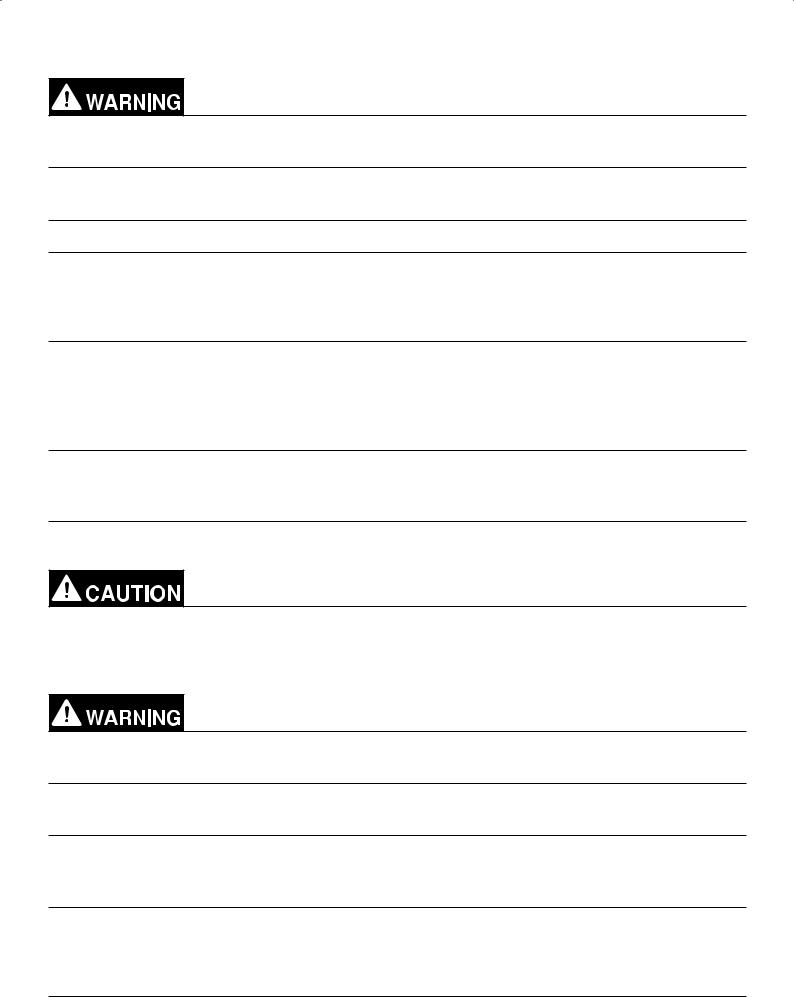
1-3. Precautions for unit installation
Do not install the unit where combustible gas may leak.
--If combustible gas accumulates around the unit, fire or explosion may result.
Do not allow children to play with the packing materials.
--Suffocation or serious injury may result.
Cut up the packing materials before disposal.
All installation work must be performed by qualified personnel in accordance with this manual.
--Improper installation may result in refrigerant leakage, water leakage, serious injury, electric shock, or fire.
If the air conditioner is installed in a small room, take measures to prevent the refrigerant concentration from exceeding the safety limit in the event of refrigerant leakage.
--Consult your dealer regarding the appropriate measures to prevent the allowable concentration from being exceeded. If the refrigerant leaks and the allowable concentration is exceeded, hazards due to a lack of oxygen in the room will result.
Install the unit in accordance with the instructions to minimize the risk of damage from earthquakes and strong winds.
--Improper installation will cause the unit to topple, resulting in serious injury.
The unit must be securely installed on a structure that can sustain its weight.
--Failure to do so will cause the unit to fall, resulting in serious injury.
Seal all openings around pipes and wires to keep out small animals, rainwater, or snow.
--Failure to do so may result in current leakage, electric shock, or damage to the unit.
1-4. Precautions for piping work
Before heating the brazed sections, remove the gas and oil that are trapped in the pipes.
--Failure to do so may generate fire, resulting in serious injury.
Do not purge the air using refrigerant. Use a vacuum pump to evacuate the system.
--Residual gas in the refrigerant lines will cause bursting of the pipes or an explosion.
Do not use oxygen, flammable gas, or a refrigerant containing chlorine for air-tightness testing.
--Doing so may result in an explosion. Chlorine will deteriorate the refrigerant oil.
When installing or relocating the unit, do not allow air or any substance other than the specified refrigerant to enter the refrigerant lines.
--Any substance other than the specified refrigerant may cause abnormally high pressure in the refrigerant lines, resulting in bursting of the pipes or an explosion.
After the installation has been completed, check for refrigerant leaks.
--If the refrigerant leaks, oxygen starvation may result. If the leaked refrigerant comes in contact with a heat source, toxic gas will be generated.
WT07281X03 |
GB-4 |
|
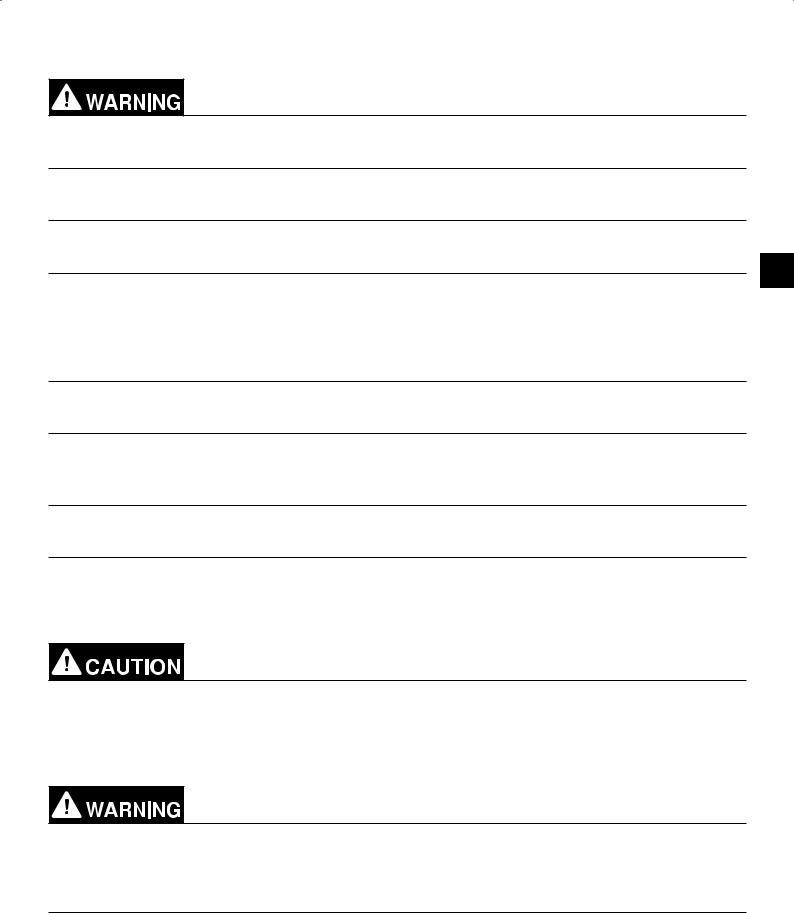
1-5. Precautions for electrical wiring
Include some slack in the power cables.
--Failure to do so may break or overheat the cables, resulting in smoke or fire.
Connections must be made securely and without tension on the terminals.
--Improperly connected cables may break, overheat, or cause smoke or fire.
Tighten all terminal screws to the specified torque.
--Loose screws and contact failure may result in smoke or fire.
Electrical work must be performed by qualified personnel in accordance with local regulations and the instructions provided in this manual. Only use the specified cables and dedicated circuits.
--Inadequate power source capacity or improper electrical work will result in electric shock, malfunction, or fire.
Install an inverter circuit breaker on the power supply of each unit.
--Failure to do so may result in electric shock or fire.
Only use properly rated breakers (an earth leakage breaker, local switch <a switch + fuse that meets local electrical codes>, or overcurrent breaker).
--Failure to do so may result in electric shock, malfunction, smoke, or fire.
Only use standard power cables of sufficient capacity.
--Failure to do so may result in current leakage, overheating, smoke, or fire.
Proper grounding must be provided by qualified personnel.
--Improper grounding may result in electric shock, fire, explosion, or malfunction due to electrical noise. Do not connect the ground wire to gas or water pipes, lightning rods, or telephone ground wires.
After the wiring work has been completed, measure the insulation resistance, and make sure that it reads at least 1 MΩ.
--Failure to do so may result in electric leakage, malfunction, or fire.
1-6. Precautions for relocating or repairing the unit
Only qualified personnel must relocate or repair the unit. Do not attempt to disassemble or alter the unit.
--Failure to do so will result in refrigerant leakage, water leakage, serious injury, electric shock, or fire.
Do not service the unit in the rain.
--Doing so may result in electric leakage, electric shock, wire shorting, malfunction, smoke, or fire.
<![endif]>GB
WT07281X03 |
GB-5 |
|

1-7. Additional precautions
Do not turn off the power immediately after stopping operation.
--Wait for at least five minutes after the unit has stopped before turning off the power. Failure to do so may result in drain water leakage or the mechanical failure of sensitive parts.
The unit must be periodically inspected by a dealer or qualified personnel.
--If dust or dirt accumulates inside the unit, the drain pipes may become clogged, and water leakage from the pipes may wet the surroundings and generate odours.
Turn on the power at least 12 hours before starting operation. Keep the power turned on throughout the operating season.
--Insufficient energizing will result in malfunction.
Do not use the air conditioner for special purposes (e.g. keeping food, animals, plants, precision devices, or art objects in a room).
--Such items could be damaged or deteriorated.
Collect the refrigerant and properly dispose of it in accordance with local regulations.
Do not install the unit on or over items that are subject to water damage.
--When the room humidity exceeds 80% or if the drain pipe is clogged, condensation may collect and drip from the indoor unit onto the ceiling or floor.
Drain piping must be installed by a dealer or qualified personnel to ensure proper drainage.
--Improper drain piping may cause water leakage, resulting in damage to furniture and other surroundings.
Take appropriate measures against electrical noise interference when installing the unit in hospitals or radio communication facilities.
--Inverter, high-frequency medical, or wireless communication equipment as well as power generators may cause the air conditioning system to malfunction. The air conditioning system may also adversely affect the operation of these types of equipment by creating electrical noise.
Insulate pipes to prevent condensation.
--Condensation may collect and drip from the unit onto the ceiling or floor.
Keep the service valves closed until refrigerant charging is completed.
--Failure to do so will damage the unit.
Place a wet towel on the service valves before brazing the pipes to keep the temperature of the valves from rising above 120ºC (248ºF).
--Failure to do so may result in equipment damage.
Keep the flame out of contact with the cables and metal sheet when brazing the pipes.
--Failure to do so may result in burnout or malfunction.
Use the following tools specifically designed for use with the specified refrigerant: Gauge manifold, charge hose, gas leak detector, check valve, refrigerant charge base, vacuum gauge, and refrigerant recovery equipment.
--Gas leak detectors for conventional refrigerants will not react to a refrigerant that does not contain chlorine.
--If the specified refrigerant is mixed with water, refrigerant oil, or another refrigerant, the refrigerant oil will deteriorate and the compressor will malfunction.
WT07281X03 |
GB-6 |
|
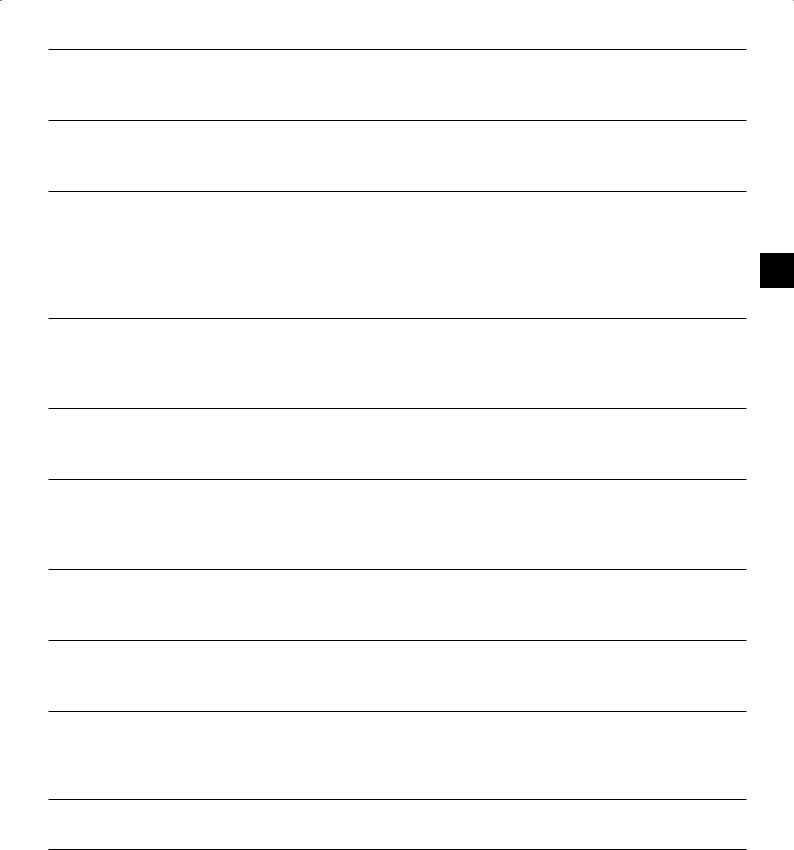
Use a vacuum pump with a check valve.
--If the vacuum pump oil flows back into the refrigerant lines, the refrigerant oil may deteriorate and the compressor may malfunction.
Keep tools clean.
--If dust, dirt, or water accumulates on the charging hose or the flare processing tool, the refrigerant will deteriorate and the compressor will malfunction.
Use refrigerant piping made of phosphorus deoxidized copper (copper and copper alloy seamless pipes) that meets local requirements. Pipe joints should also meet local requirements. Keep the inner and outer surfaces of the pipes clean and free of sulphur, oxides, dust/dirt, shaving particles, oils, moisture, or any other contaminants.
--Contaminants on the inside of the refrigerant piping will cause the refrigerant oil to deteriorate and cause the compressor to malfunction.
Store pipes indoors, and keep both ends of the pipes sealed until just before making a flare connection or brazing. (Store elbows and other joints in plastic bags.)
--If dust, dirt, or water enters the refrigerant lines, the refrigerant oil will deteriorate and the compressor will malfunction.
Braze the pipes with a nitrogen purge to avoid oxidation.
--Oxidized flux inside the refrigerant pipes will cause the refrigerant oil to deteriorate and cause the compressor to malfunction.
Do not use existing refrigerant piping.
--The old refrigerant and refrigerant oil in the existing piping contain a large amount of chlorine, which will cause the refrigerant oil in the new unit to deteriorate and cause the compressor to malfunction.
Charge refrigerant in a liquid state.
--Charging refrigerant in the gaseous state will change the composition of the refrigerant and lead to a performance drop.
Do not use a charging cylinder when charging refrigerant.
--The use of a charging cylinder may change the composition of the refrigerant and lead to a performance drop.
If a large electric current flows due to a malfunction or faulty wiring, earth-leakage breakers on the unit side and on the upstream side of the power supply system could both operate. Depending on the importance of the system, separate the power supply system or take protective coordination of breakers.
This appliance is intended to be used by expert or trained users in shops, in light industry and on farms, or for commercial use by lay persons.
This appliance is not intended for use by persons (including children) with reduced physical, sensory or mental capabilities, or lack of experience and knowledge, unless they have been given supervision or instruction concerning use of the appliance by a person responsible for their safety.
<![endif]>GB
WT07281X03 |
GB-7 |
|

2. About the product
The outdoor unit described in this manual is air-conditioning equipment that is designed only for human comfort.The numeric values in the unit model name (e.g., PUHY-EP***-YLM-A) indicate the capacity index of the unit.This unit uses R410A refrigerant.
3. Combination of outdoor units
Outdoor unit model |
|
Combination of outdoor units |
|
PUHY-EP200YLM-A(-BS) |
- |
- |
- |
PUHY-EP250YLM-A(-BS) |
- |
- |
- |
PUHY-EP300YLM-A(-BS) |
- |
- |
- |
PUHY-EP350YLM-A(-BS) |
- |
- |
- |
PUHY-EP400YLM-A(-BS) |
- |
- |
- |
PUHY-EP450YLM-A(-BS) |
- |
- |
- |
PUHY-EP500YLM-A(-BS) |
- |
- |
- |
PUHY-EP500YSLM-A(-BS) |
PUHY-EP250YLM-A(-BS) |
PUHY-EP250YLM-A(-BS) |
- |
PUHY-EP550YSLM-A(-BS) |
PUHY-EP300YLM-A(-BS) |
PUHY-EP250YLM-A(-BS) |
- |
PUHY-EP600YSLM-A(-BS) |
PUHY-EP300YLM-A(-BS) |
PUHY-EP300YLM-A(-BS) |
- |
PUHY-EP650YSLM-A(-BS) |
PUHY-EP250YLM-A(-BS) |
PUHY-EP200YLM-A(-BS) |
PUHY-EP200YLM-A(-BS) |
PUHY-EP700YSLM-A(-BS) |
PUHY-EP300YLM-A(-BS) |
PUHY-EP200YLM-A(-BS) |
PUHY-EP200YLM-A(-BS) |
PUHY-EP750YSLM-A(-BS) |
PUHY-EP300YLM-A(-BS) |
PUHY-EP250YLM-A(-BS) |
PUHY-EP200YLM-A(-BS) |
PUHY-EP800YSLM-A(-BS) |
PUHY-EP300YLM-A(-BS) |
PUHY-EP300YLM-A(-BS) |
PUHY-EP200YLM-A(-BS) |
PUHY-EP850YSLM-A(-BS) |
PUHY-EP300YLM-A(-BS) |
PUHY-EP300YLM-A(-BS) |
PUHY-EP250YLM-A(-BS) |
PUHY-EP900YSLM-A(-BS) |
PUHY-EP300YLM-A(-BS) |
PUHY-EP300YLM-A(-BS) |
PUHY-EP300YLM-A(-BS) |
PUHY-EP950YSLM-A(-BS) |
PUHY-EP350YLM-A(-BS) |
PUHY-EP300YLM-A(-BS) |
PUHY-EP300YLM-A(-BS) |
PUHY-EP1000YSLM-A(-BS) |
PUHY-EP400YLM-A(-BS) |
PUHY-EP300YLM-A(-BS) |
PUHY-EP300YLM-A(-BS) |
PUHY-EP1050YSLM-A(-BS) |
PUHY-EP400YLM-A(-BS) |
PUHY-EP350YLM-A(-BS) |
PUHY-EP300YLM-A(-BS) |
PUHY-EP1100YSLM-A(-BS) |
PUHY-EP400YLM-A(-BS) |
PUHY-EP350YLM-A(-BS) |
PUHY-EP350YLM-A(-BS) |
PUHY-EP1150YSLM-A(-BS) |
PUHY-EP450YLM-A(-BS) |
PUHY-EP350YLM-A(-BS) |
PUHY-EP350YLM-A(-BS) |
PUHY-EP1200YSLM-A(-BS) |
PUHY-EP450YLM-A(-BS) |
PUHY-EP400YLM-A(-BS) |
PUHY-EP350YLM-A(-BS) |
PUHY-EP1250YSLM-A(-BS) |
PUHY-EP450YLM-A(-BS) |
PUHY-EP450YLM-A(-BS) |
PUHY-EP350YLM-A(-BS) |
PUHY-EP1300YSLM-A(-BS) |
PUHY-EP450YLM-A(-BS) |
PUHY-EP450YLM-A(-BS) |
PUHY-EP400YLM-A(-BS) |
PUHY-EP1350YSLM-A(-BS) |
PUHY-EP450YLM-A(-BS) |
PUHY-EP450YLM-A(-BS) |
PUHY-EP450YLM-A(-BS) |
* "Twinning Kit" is required to connect combination units on site.
WT07281X03 |
GB-8 |
|

4. Specifications
Model |
|
|
PUHY-EP200YLM-A |
PUHY-EP250YLM-A |
PUHY-EP300YLM-A |
PUHY-EP350YLM-A |
PUHY-EP400YLM-A |
|
|
Sound level (50/60 Hz) |
|
57 dB <A> |
60 dB <A> |
61 dB <A> |
61 dB <A> |
62.5 dB <A> |
|
|
|
External static pressure |
|
|
|
0 Pa*2 |
|
|
|
|
|
|
Total capacity |
|
|
50% to 130%*1 |
|
|
|
|
|
Indoor unit |
Model |
|
|
15 to 250 |
|
|
|
|
|
|
Quantity |
1 to 17 |
1 to 21 |
1 to 26 |
1 to 30 |
1 to 34 |
|
|
|
Temperature |
Indoor |
W.B. |
|
+15.0°C to +24.0°C (+59.0°F to +75.0°F) |
|
|
|
||
range (Cooling) |
Outdoor |
D.B. |
|
-5.0°C to +52.0°C (+23.0°F to +126.0°F) |
|
|
|
||
Temperature |
Indoor |
D.B. |
|
+15.0°C to +27.0°C (+59.0°F to +81.0°F) |
|
|
|
||
range (Heating) |
Outdoor |
W.B. |
|
-20.0°C to +15.5°C (-4.0°F to +60.0°F) |
|
|
|
||
|
|
|
<![if ! IE]> <![endif]>GB |
||||||
|
|
|
|
|
|
|
|
|
|
Model |
|
|
PUHY-EP450YLM-A |
PUHY-EP500YLM-A |
PUHY-EP500YSLM-A |
PUHY-EP550YSLM-A |
PUHY-EP600YSLM-A |
|
|
|
|
|
|
||||||
|
|
|
|||||||
Sound level (50/60 Hz) |
|
63 dB <A> |
63.5 dB <A> |
63 dB <A> |
63.5 dB <A> |
64 dB <A> |
|
|
|
External static pressure |
|
|
|
0 Pa*2 |
|
|
|
|
|
|
Total capacity |
|
|
50% to 130%*1 |
|
|
|
|
|
Indoor unit |
Model |
|
|
15 to 250 |
|
|
|
|
|
|
Quantity |
1 to 39 |
1 to 43 |
1 to 43 |
2 to 47 |
2 to 50 |
|
|
|
Temperature |
Indoor |
W.B. |
|
+15.0°C to +24.0°C (+59.0°F to +75.0°F) |
|
|
|
||
range (Cooling) |
Outdoor |
D.B. |
|
-5.0°C to +52.0°C (+23.0°F to +126.0°F) |
|
|
|
||
Temperature |
Indoor |
D.B. |
|
+15.0°C to +27.0°C (+59.0°F to +81.0°F) |
|
|
|
||
range (Heating) |
Outdoor |
W.B. |
|
-20.0°C to +15.5°C (-4.0°F to +60.0°F) |
|
|
|
||
|
|
|
|
|
|||||
Model |
|
|
PUHY-EP650YSLM-A |
PUHY-EP700YSLM-A |
PUHY-EP750YSLM-A |
PUHY-EP800YSLM-A |
PUHY-EP850YSLM-A |
|
|
Sound level (50/60 Hz) |
|
63 dB <A> |
63.5 dB <A> |
64.5 dB <A> |
65 dB <A> |
65.5 dB <A> |
|
|
|
External static pressure |
|
|
|
0 Pa*2 |
|
|
|
|
|
|
Total capacity |
|
|
50% to 130%*1 |
|
|
|
|
|
Indoor unit |
Model |
|
|
15 to 250 |
|
|
|
|
|
|
Quantity |
2 to 50 |
2 to 50 |
2 to 50 |
2 to 50 |
2 to 50 |
|
|
|
Temperature |
Indoor |
W.B. |
|
+15.0°C to +24.0°C (+59.0°F to +75.0°F) |
|
|
|
||
range (Cooling) |
Outdoor |
D.B. |
|
-5.0°C to +52.0°C (+23.0°F to +126.0°F) |
|
|
|
||
Temperature |
Indoor |
D.B. |
|
+15.0°C to +27.0°C (+59.0°F to +81.0°F) |
|
|
|
||
range (Heating) |
Outdoor |
W.B. |
|
-20.0°C to +15.5°C (-4.0°F to +60.0°F) |
|
|
|
||
|
|
|
|
|
|
||||
Model |
|
|
PUHY-EP900YSLM-A |
PUHY-EP950YSLM-A |
PUHY-EP1000YSLM-A |
PUHY-EP1050YSLM-A |
PUHY-EP1100YSLM-A |
|
|
Sound level (50/60 Hz) |
|
66 dB <A> |
66 dB <A> |
66.5 dB <A> |
66.5 dB <A> |
66.5 dB <A> |
|
|
|
External static pressure |
|
|
|
0 Pa*2 |
|
|
|
|
|
|
Total capacity |
|
|
50% to 130%*1 |
|
|
|
|
|
Indoor unit |
Model |
|
|
15 to 250 |
|
|
|
|
|
|
Quantity |
2 to 50 |
2 to 50 |
2 to 50 |
3 to 50 |
3 to 50 |
|
|
|
Temperature |
Indoor |
W.B. |
|
+15.0°C to +24.0°C (+59.0°F to +75.0°F) |
|
|
|
||
range (Cooling) |
Outdoor |
D.B. |
|
-5.0°C to +52.0°C (+23.0°F to +126.0°F) |
|
|
|
||
Temperature |
Indoor |
D.B. |
|
+15.0°C to +27.0°C (+59.0°F to +81.0°F) |
|
|
|
||
range (Heating) |
Outdoor |
W.B. |
|
-20.0°C to +15.5°C (-4.0°F to +60.0°F) |
|
|
|
||
|
|
|
|
|
|||||
Model |
|
|
PUHY-EP1150YSLM-A |
PUHY-EP1200YSLM-A |
PUHY-EP1250YSLM-A |
PUHY-EP1300YSLM-A |
PUHY-EP1350YSLM-A |
|
|
Sound level (50/60 Hz) |
|
66.5 dB <A> |
67 dB <A> |
67.5 dB <A> |
68 dB <A> |
68 dB <A> |
|
|
|
External static pressure |
|
|
|
0 Pa*2 |
|
|
|
|
|
|
Total capacity |
|
|
50% to 130%*1 |
|
|
|
|
|
Indoor unit |
Model |
|
|
15 to 250 |
|
|
|
|
|
|
Quantity |
3 to 50 |
3 to 50 |
3 to 50 |
3 to 50 |
3 to 50 |
|
|
|
Temperature |
Indoor |
W.B. |
|
+15.0°C to +24.0°C (+59.0°F to +75.0°F) |
|
|
|
||
range (Cooling) |
Outdoor |
D.B. |
|
-5.0°C to +52.0°C (+23.0°F to +126.0°F) |
|
|
|
||
Temperature |
Indoor |
D.B. |
|
+15.0°C to +27.0°C (+59.0°F to +81.0°F) |
|
|
|
||
range (Heating) |
Outdoor |
W.B. |
|
-20.0°C to +15.5°C (-4.0°F to +60.0°F) |
|
|
|
||
*1 The maximum total capacity of indoor units operating simultaneously is 130%.
*2 To enable the high static pressure setting, set the dipswitch on the main board as follows. SW6-4: ON
SW6-5: OFF (60 Pa) or ON (30 Pa)
WT07281X03 |
GB-9 |
|
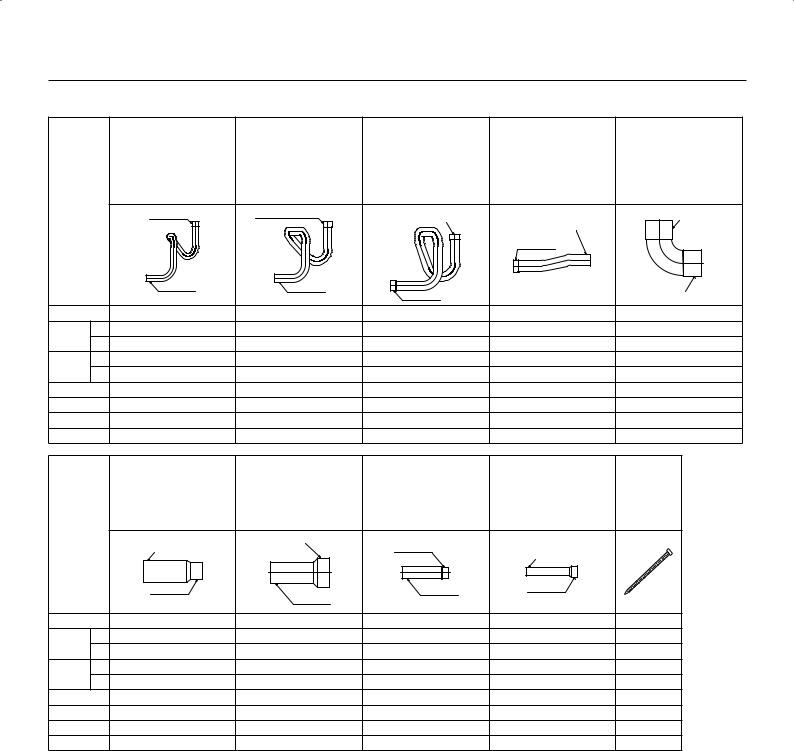
5. Package contents
The table below lists all the parts and their quantities included in the package.
|
|
|
|
|
*5 |
*5 |
|
|
Connecting pipe |
Connecting pipe |
Connecting pipe |
Connecting pipe |
Connecting elbow |
|
|
(Liquid side) |
(Liquid side) |
(Liquid side) |
(Gas side) |
(Gas side) |
|
|
ID ø9.52 mm (ø3/8 in) |
ID ø12.7 mm (ø1/2 in) |
ID ø15.88 mm (ø5/8 in) |
OD ø28.58 mm (ø1-1/8 in) |
ID ø28.58 mm (ø1-1/8 in) |
|
|
ID ø15.88 mm (ø5/8 in) |
||||
|
|
OD ø9.52 mm (ø3/8 in) |
ID ø15.88 mm (ø5/8 in) |
ID ø28.58 mm (ø1-1/8 in) |
ID ø28.58 mm (ø1-1/8 in) |
|
|
|
OD ø12.7 mm (ø1/2 in) |
||||
|
|
|
|
|
|
|
|
|
ID ø9.52 |
ID ø12.7, ø15.88 |
ID ø15.88 |
OD ø28.58 |
ID ø28.58 |
|
|
|
|
|
|
|
|
|
|
|
|
ID ø28.58 |
|
|
|
ø9.52 |
ø12.7 |
ø15.88 |
|
|
|
|
OD ø9.52 |
OD ø12.7 |
|
ø28.58 |
ID ø28.58 |
|
|
ID ø15.88 |
|
|||
|
|
|
|
|
|
|
EP200 |
|
1 |
- |
- |
- |
1 |
EP250 |
*1 |
1 |
- |
- |
- |
1 |
*2 |
1 |
- |
- |
- |
1 |
|
EP300 |
*3 |
- |
1 (ID ø12.7) |
- |
1 |
1 |
*4 |
- |
1 (ID ø12.7) |
- |
1 |
1 |
|
EP350 |
|
- |
1 (ID ø12.7) |
- |
1 |
1 |
EP400 |
|
- |
1 (ID ø15.88) |
- |
1 |
1 |
EP450 |
|
- |
- |
1 |
1 |
1 |
EP500 |
|
- |
- |
1 |
1 |
1 |
|
|
*5 |
*6 |
|
|
|
|
|
Connecting pipe |
Connecting pipe |
Connecting pipe |
Connecting pipe |
|
|
|
(Gas side) |
(Gas side) |
(Liquid side) |
(Liquid side) |
Tie band |
|
|
OD ø28.58 mm (ø1-1/8 in) |
ID ø28.58 mm (ø1-1/8 in) |
ID ø9.52 mm (ø3/8 in) |
ID ø12.7 mm (ø1/2 in) |
|
|
|
|
||||
|
|
ID ø22.2 mm (ø7/8 in) |
OD ø22.2 mm (ø7/8 in) |
OD ø12.7 mm (ø1/2 in) |
OD ø9.52 mm (ø3/8 in) |
|
|
|
OD ø28.58 |
ID ø28.58 |
ID ø9.52 |
|
|
|
|
ø22.2 |
OD ø9.52 |
|
||
|
|
|
|
|
||
|
|
ID ø22.2 |
OD ø22.2 |
OD ø12.7 |
ID ø12.7 |
|
|
|
|
|
|
|
|
EP200 |
|
1 |
1 |
- |
- |
2 |
EP250 |
*1 |
1 |
1 |
- |
- |
2 |
*2 |
1 |
1 |
1 |
- |
2 |
|
EP300 |
*3 |
- |
- |
- |
1 |
2 |
|
*4 |
- |
- |
- |
- |
2 |
EP350 |
|
- |
- |
- |
- |
2 |
EP400 |
|
- |
- |
- |
- |
2 |
EP450 |
|
- |
- |
- |
- |
2 |
EP500 |
|
- |
- |
- |
- |
2 |
*1 When the piping length from the outdoor unit to the farthest indoor unit is less than 90 m (295 ft) *2 When the piping length from the outdoor unit to the farthest indoor unit is 90 m (295 ft) or more *3 When the piping length from the outdoor unit to the farthest indoor unit is less than 40 m (131 ft) *4 When the piping length from the outdoor unit to the farthest indoor unit is 40 m (131 ft) or more *5 Used only when routing the pipes through the front of the unit
*6 Used only when routing the pipes through the bottom of the unit
WT07281X03 |
GB-10 |
|
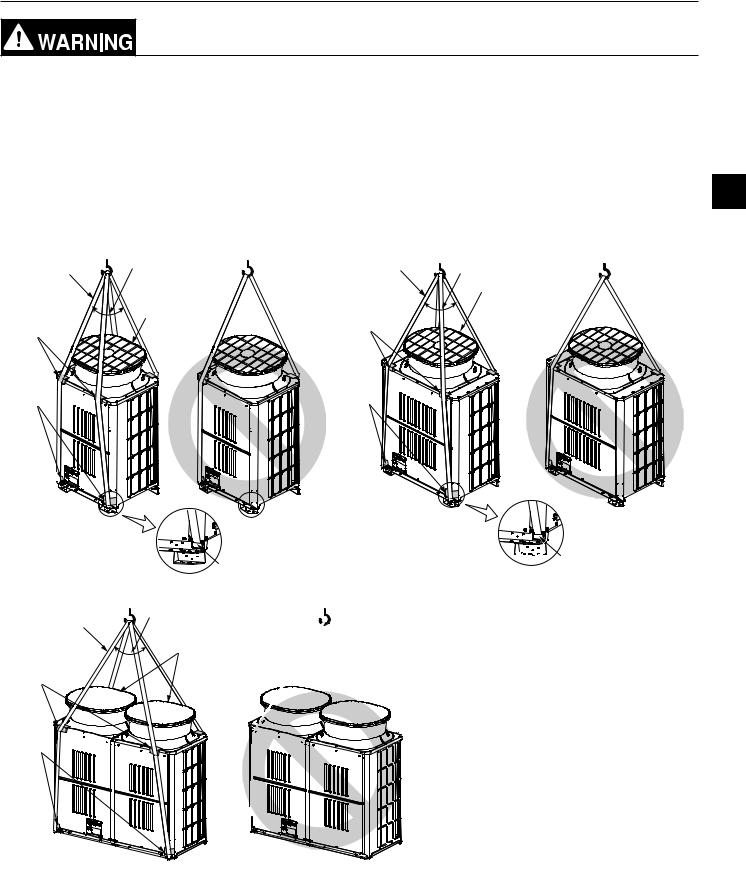
6. Transporting the unit
When lifting the unit, pass the slings through the four designated sling holes.
--Improper lifting will cause the unit to topple or fall, resulting in serious injury.
Always use two slings to lift up the unit. Each sling must be at least 8 m (26 ft) long and must be able to support the weight of the unit.
Put protective pads between slings and the unit where the slings touch the unit at the base to protect the unit from being scratched.
Put 50 mm (2 in) or thicker protective pads between slings and the unit where the slings touch the unit at the top of the unit to protect the unit from being scratched and to avoid contact with the slings and the fan guard.
Make sure that the angles between slings at the top are less than 40 degrees.
EP200 to EP250 |
|
EP300 to EP350 |
|
|
≤ 40° |
|
≤ 40° |
|
|||
|
|
|
|
|
|
|
|
|
|
|
|
|
|
|
|
|
|
|
|
|


EP400 to EP500
≤ 40°
Slings (Min. 8 m (26 ft) x 2)
Protective pads (Minimum thickness: 50 mm (2 in))
(two each in the front and back)
Protective pads
(two each in the front and back)
Sling holes
(two each in the front and back)
Fan guard
<![endif]>GB
WT07281X03 |
GB-11 |
|
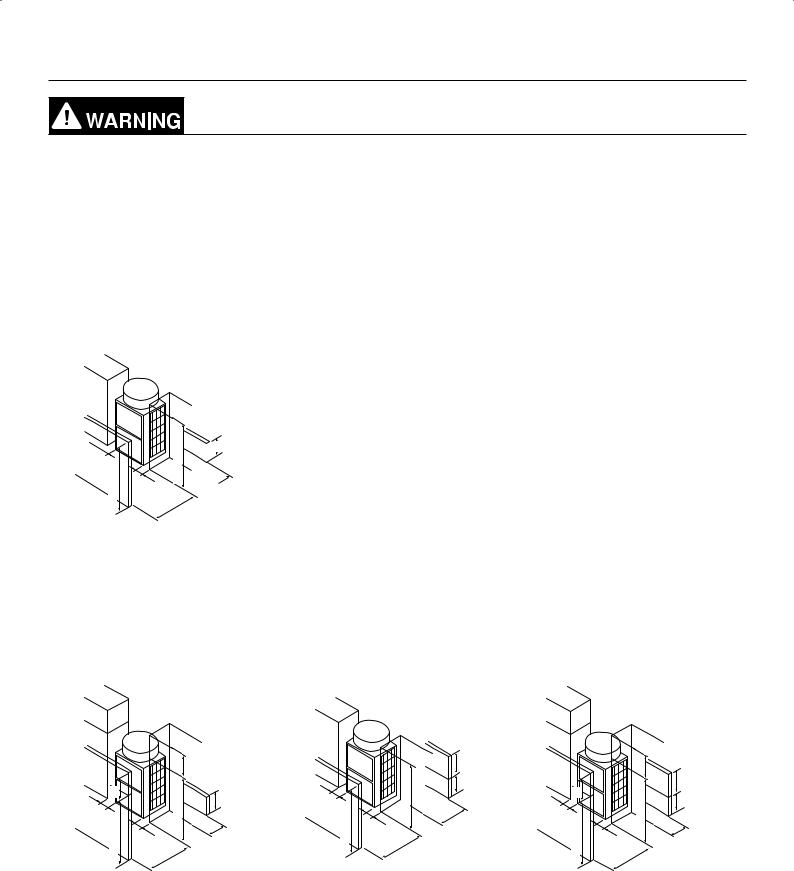
7. Installation location
Do not install the unit where combustible gas may leak.
--If combustible gas accumulates around the unit, fire or explosion may result.
Provide sufficient space around the unit for effective operation, efficient air movement, and ease of access for maintenance.
Note that refrigerant gas is heavier than air and will therefore tend to collect in low spots such as basements.
When an indoor unit that draws in outside air exits near the outdoor unit, be careful not to affect the normal operation of the indoor unit.
7-1. Single unit installation
(1) When all walls are within their height limits*.
L3 
<![endif]>≤ Unit height
L3
|
[mm (in)] |
* Height limit |
|
Front/Right/Left |
Same height or lower than the overall height of the unit |
Rear |
500 mm (19-11/16 in) or lower from the unit bottom |
| <![if ! IE]> <![endif]>heightUnit≤ |
|
|
≤ 500 (19-11/16) |
|
|
|
|
|
|||
|
|
|
|
|
|
|
|
 L2
L2
L1
|
|
Required minimum distance [mm (in)] |
||
|
L1 |
(Front) |
L2 (Rear) |
L3 (Right/Left) |
When the distance behind the unit (L2) needs to be small |
450 |
(17-3/4) |
100 (3-15/16) |
50 (2) |
When the distance to the right or left (L3) needs to be small |
450 |
(17-3/4) |
300 (11-13/16) |
15 (5/8) |
(2) When one or more walls exceed their height limits*.
When the wall(s) at the front and/ |
When the wall at the rear exceeds |
or the right/left exceed(s) their |
its height limit |
height limits |
|
When all walls exceed their height limits
|
|
h3 |
|
|
|
|
h2 |
|
|
h3 |
|
|
|
|
|
|
|
<![if ! IE]> <![endif]>≤ Unit height |
500 |
|
|
|
h2 |
h1 |
|
|
|
|
|
(19-11/16) |
h1 |
|
|
||
|
<![if ! IE]> <![endif]>Unit height |
≤ 500 |
L3 |
|
|
|
<![if ! IE]> <![endif]>Unit height |
500 |
|||
L3 |
|
(19-11/16) |
<![if ! IE]> <![endif]>Unit height |
|
|
L3 |
|
(19-11/16) |
|||
| <![if ! IE]> <![endif]>height |
|
|
L3 |
L2 |
<![if ! IE]> <![endif]>height |
|
|
||||
L3 |
L2 |
|
L3 |
L2 |
|||||||
|
|
||||||||||
| <![if ! IE]> <![endif]>Unit |
|
L1 |
|
<![if ! IE]> <![endif]>≤ |
|
L1 |
|
<![if ! IE]> <![endif]>Unit |
|
L1 |
|
|
|
|
|
|
|
|
|
|
|
Add the dimension that exceeds the height limit (shown as "h1" through "h3" in the figures) to L1, L2, and L3 as shown in the table below.
|
Required minimum distance [mm (in)] |
||
|
L1 (Front) |
L2 (Rear) |
L3 (Right/Left) |
When the distance behind the unit (L2) needs to be small |
450 (17-3/4) + h1 |
100 (3-15/16) + h2 |
50 (2) + h3 |
When the distance to the right or left (L3) needs to be small |
450 (17-3/4) + h1 |
300 (11-13/16) + h2 |
15 (5/8) + h3 |
WT07281X03 |
GB-12 |
|
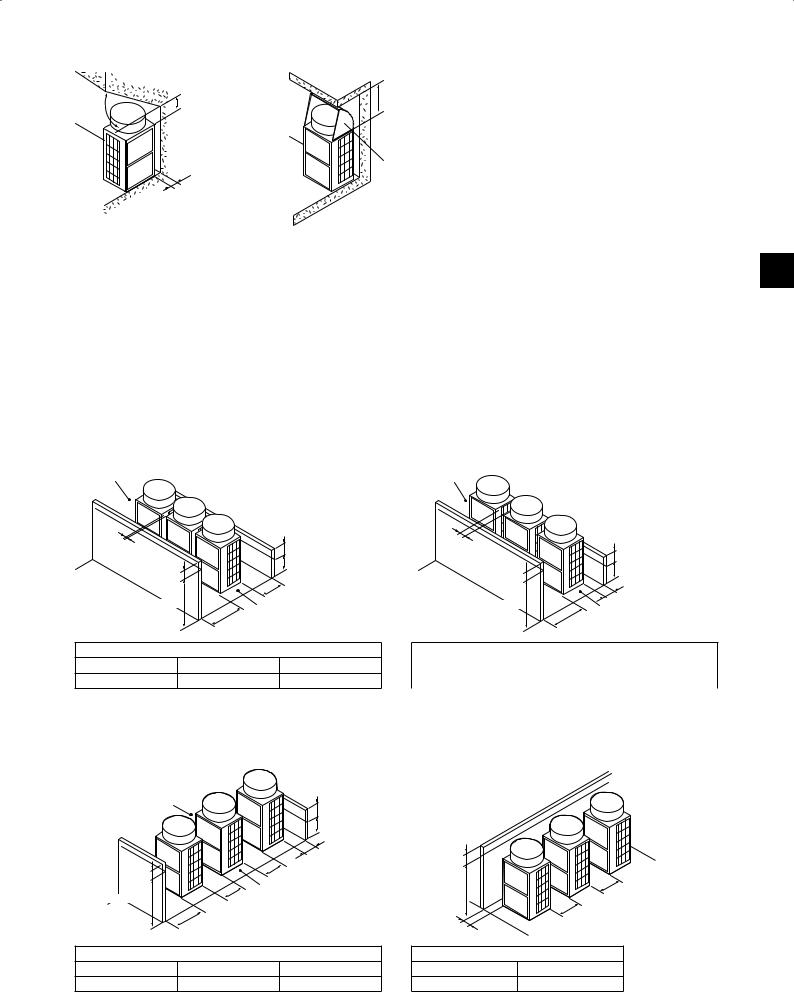
(3) When there are overhead obstacles
≥ 240 (9-1/2) |
≥ 1000 (39-3/8) |
|
|
≥ 45° |
|
|
Air outlet guide |
|
(not supplied) |
≥ 50 (2) |
|
7-2. Multiple unit installation
When installing multiple units, make sure to take into consideration factors such as providing enough space for people to pass through, ample space between blocks of units, and sufficient space for airflow. (The areas marked with in the figures below must be left open.)
In the same way as with the single unit installation, add the dimension that exceeds the height limit (shown as "h1" through "h3" in the figures) to L1, L2, and L3 as shown in the tables below.
If there are walls in the front and rear of the block of units, up to six units (three units for units EP400 through EP500) can be installed consecutively side by side, and a space of 1000 mm (39-3/8 in) or more must be left between each block of six units.
(1) Side-by-side installation
When the distances between the units (L4) need to be small
L4 |
|
|
h2 |
|
|
|
500 (19-11/16) |
|
h1 |
|
|
Unit height |
|
L2 |
|
|
|
||
|
|
|
|
|
|
L1 |
|
Required minimum distance [mm (in)] |
|||
L1 (Front) |
|
L2 (Rear) |
L4 (Between) |
450 (17-3/4) + h1 |
300 (11-13/16) + h2 |
30 (1-3/16) |
|
When the distance behind the block of units (L2) needs to be small
L4 |
|
|
|
h2 |
|
h1 |
500 (19-11/16) |
|
|
||
Unit height |
L2 |
|
|
||
|
||
|
L1 |
|
Required minimum distance [mm (in)] |
||
L1 (Front) |
L2 (Rear) |
L4 (Between) |
450 (17-3/4) + h1 |
100 (3-15/16) + h2 |
100 (3-15/16) |
(2)Face-to-face installation
When there are walls in the front and rear of the block of units
|
|
h2 |
|
|
|
|
|
500 (19-11/16) |
|
|
L2 |
h1 |
|
L4 |
|
|
|
Unit height |
L4 |
|
|
L1 |
|
Required minimum distance [mm (in)] |
||
L1 (Front) |
L2 (Rear) |
L4 (Between) |
450 (17-3/4) + h1 |
100 (3-15/16) + h2 |
450 (17-3/4) |
When there is a wall on either the right or left side of the block of units
h3 |
|
Unit height |
L4 |
|
L4 |
L3 |
|
Required minimum distance [mm (in)] |
|
L3 (Right/Left) |
L4 (Between) |
15 (5/8) + h3 |
450 (17-3/4) |
<![endif]>GB
WT07281X03 |
GB-13 |
|
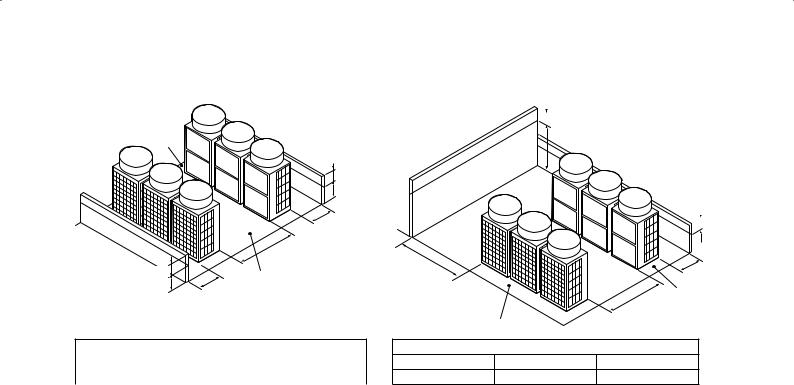
(3) Combination of face-to-face and side-by-side installations
When there are walls in the front and rear of the block of units
|
|
|
h2 |
|
500 |
|
(19-11/16) |
|
L2 |
|
L4 |
h2’ |
|
|
|
500 (19-11/16) |
L2’ |
Required minimum distance [mm (in)]
L2 (Right) |
L2' (Left) |
L4 (Between) |
300 (11-13/16) + h2 |
300 (11-13/16) + h2' |
900 (35-7/16) |
Leave open in two directions.
When there are two walls in an L-shape
 h3
h3
Unit height

 h2
h2
500
 (19-11/16)
(19-11/16)
L3 |
|
L2 |
|
|
|
|
|
|
|
|
L4 |
|
|
|
Required minimum distance [mm (in)] |
||
L2 (Right) |
L3 (Right/Left) |
L4 (Between) |
300 (11-13/16) + h2 |
1000 (39-3/8) + h3 |
900 (35-7/16) |
WT07281X03 |
GB-14 |
|
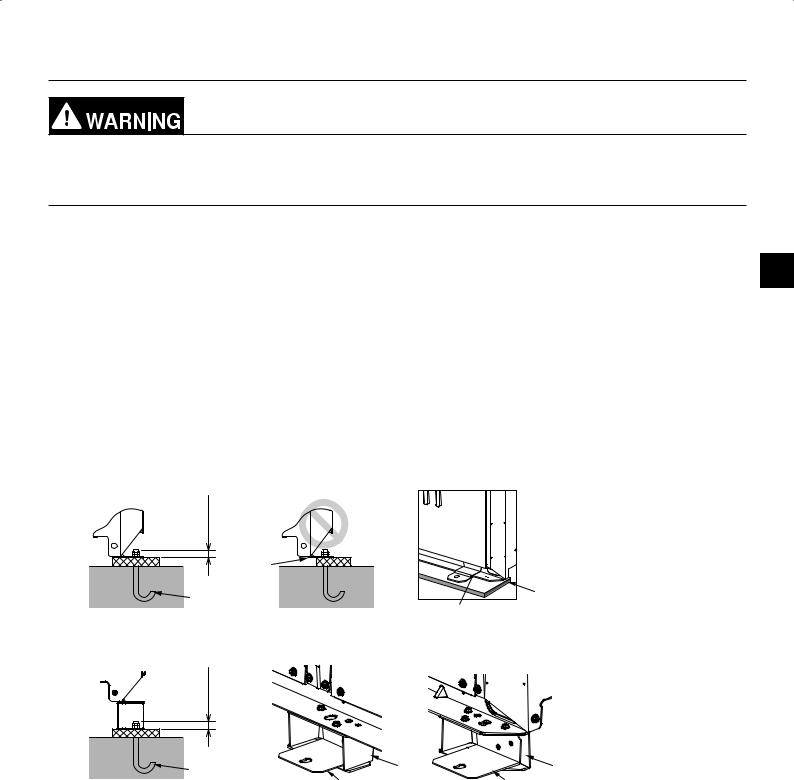
8. Foundation work
Install the unit in accordance with the instructions to minimize the risk of damage from earthquakes and strong winds.
--Improper installation will cause the unit to topple, resulting in serious injury.
The unit must be securely installed on a structure that can sustain its weight.
--Failure to do so will cause the unit to fall, resulting in serious injury.
When performing the foundation work, make sure that the floor surface has sufficient strength and carefully route pipes and wires in consideration of the water drainage that will be required when the unit is operated.
If considering routing the pipes and wires across the bottom of the unit, make sure that the base is at least 100 mm (3-15/16 in) high so that the through-holes will not be blocked.
Provide a strong base of concrete or angle iron. If a stainless steel base is used, insulate the area between the base and the outdoor unit by putting a rubber cushion or by applying an electrically insulated coating to prevent the base from rusting.
Install the unit on a level surface.
With some types of installation, unit vibration and sound will be transmitted to the floors and walls. In such locations, take measures to prevent vibration (such as using anti-vibration rubber pads).
[mm (in)]
(1) Without a detachable leg
| <![if ! IE]> <![endif]>≤ 30 (1-3/16) |
|
|
|
|
(2) With a detachable leg
| <![if ! IE]> <![endif]>≤ 30 (1-3/16) |
|
|
|
|
|
M10 anchor bolt (not supplied)
(Incorrect installation) The corner section is not securely received.
Fixing bracket for post-installed anchor bolts (not supplied) (To be fixed with three screws)
Anti-vibration rubber pad
(The pad needs to be large enough to cover the entire width of each unit leg.)
Detachable leg
Make sure that the corner section is securely received. If not, the unit legs could bend.The length of the projecting part of the anchor bolt should be 30 mm (1-3/16 in) or less.
This unit is not designed to be anchored with post-installed anchor bolts unless fixing brackets are installed at the bottom four locations (six locations for units EP400 through EP500).
<![endif]>GB
WT07281X03 |
GB-15 |
|
